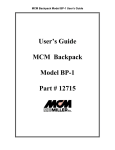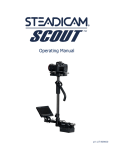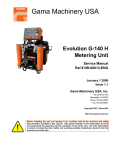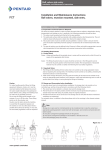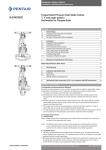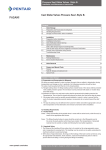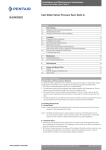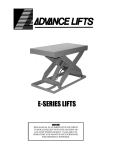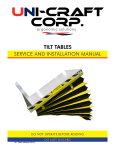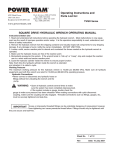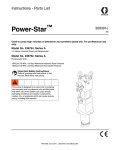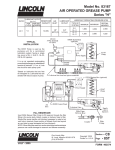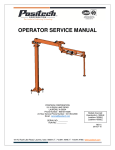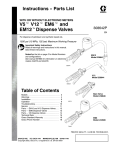Download DUAL-SEAL BALL VALVE
Transcript
WOM OPERATING & MAINTENANCE PROCEDURES FOR DUAL-SEAL BALL VALVE FOR PRODUCTION, PIPELINE, TOP-SIDE AND UNDERGROUND STORAGE SERVICES Manual Identification Number: OPM-316, Rev. 4 Revised February, 2010 A429EN1.08 Rev.4 TABLE OF CONTENTS DESCRIPTION SECTION Operating Procedures for a Model 30 and Model 30-D Dual Seal Ball Valve................................................................ I Maintenance & Lubrication for Model 30 and Model 30-D Dual Seal Ball Valve......................................................II Trouble Shooting & Routine Functional Testing for Model 30 and Model 30-D Dual Seal Ball Valve ............................ III Valve Storage .............................................................................................. IV EHSR Requirement of Warning & Caution ............................................ V Appendices Maintenance Schedule............................................................................ A Assembly Drawings.................................................................................B Bill of Materials........................................................................................ C API Specification 6D Testing Procedures............................................ D General Design Standard ........................................................................E A429EN1.08 Rev.4 SECTION I A429EN1.08 Rev.4 OPM-316 WOM MODEL 30 / MODEL 30-D OPERATING PROCEDURES REVISION: 4 DUAL SEAL SECTION: I BALL VALVE PAGE: 1 OF 5 Size: All Pressure Class: All Material Class: All Mode of Operation: All The Model 30 and Model 30-D Dual-Seal Ball Valve use a trunnion mounted ball design to achieve an upstream seal. The Model 30 Dual-Seal valve is bi-directional, and incorporates W.O.M.’s patented Dual-Seal design of two independent seals on each side of the ball for extended valve life and additional safety. The Model 30-D use the same upstream Dual-Seal design, but the addition of a modified secondary seal on the downstream side now gives the valve a third seal on the downstream side of the ball. The 30-D also has a “preferred direction of flow arrow” indicated by a stainless steel tag mounted on the side of the body. A. GENERAL OPERATING INSTRUCTIONS: Ball valves should never be used to "throttle" line fluid. Throttling any ball valve will result in seat and/or ball damage. This valve should be fully opened and fully closed. To Operate: 1. To OPEN, rotate the lever or gear box handwheel counter-clockwise the valve has moved 90 degrees and strong resistance is felt. There is a shoulder, the “end-stop,” on the valve which gives the valve a positive stop in the open position. Worm gear operated valves will have a position indication cast on to the top plate of the worm gear. These valves will travel only turn ¼ turn or 90 degrees. Reverse direction to CLOSE. 2. Power-opening with an electric actuator – use the open / closed stops on the valve or on the gear box to fully open and close the valve. The electric actuator should be set to stop with torque limits. A429EN1.08 Rev.4 OPM-316 WOM MODEL 30 / MODEL 30-D OPERATING PROCEDURES REVISION: 4 DUAL SEAL SECTION: I BALL VALVE PAGE: 2 OF 5 B. Operation Instructions for Double Block and Bleed using the Bleed Fitting: The W.O.M. Dual-Seal Ball Valve is a Double Block and Bleed valve (DBB) Double Block and Bleed can be verified by following API 6D test procedures. With the line under pressure, the valve center body cavity can be vented to the atmosphere and completely de-pressurized with the ball in either the open or closed positions. After venting, if no additional line pressure enters the valve, the seals have been proven to be intact. Bleed the body cavity pressure through the vent (bleeder) fitting located in the upper quadrant of the ball valve’s center section. This fitting has two venting ports 180 degrees opposite each other. Refer to Drawings “A” & “B”. Figure 4 (4” & Larger Ball Valves) Drawing “B” - 4” valve & Up Body Vent (Bleeder) Fitting A429EN1.08 Rev.4 OPM-316 WOM MODEL 30 / MODEL 30-D OPERATING PROCEDURES REVISION: 4 DUAL SEAL SECTION: I BALL VALVE PAGE: 3 OF 5 1. 4” and larger valves: To open the vent ports use a wrench on the upper (smaller) hex head stem of the fitting and turn the wrench counter-clockwise*. This will allow any trapped pressure in the body to vent to atmosphere. Figure 3 (2” & 3” Ball Valves) Drawing “A” - 2” & 3” valve Body Vent (Bleeder) Fitting 2. 2” and 3” valves: same procedure as for 4” and larger, but the vent fitting uses an allen head wrench to open and close the ports. 3. Close the vent fitting by turning the small hex head stem, (or allen head) clockwise until it snugs tight. This fitting must be in the closed position at all times other than for block and bleed tests. * Caution : When turning the smaller hex head, make sure the threaded body of the fitting does not unthread out of the ball valve center section. You may need to put a back-up wrench on the larger hex head. (See Figures 3 & 4) ** ALWAYS USE EYE PROTECTION DURING THIS PROCEDURE C. VENTING: No WOM ball valve can trap pressure in the body. All valves are self-relieving. A429EN1.08 Rev.4 OPM-316 WOM MODEL 30 / MODEL 30-D OPERATING PROCEDURES REVISION: 4 DUAL SEAL SECTION: I BALL VALVE PAGE: 4 OF 5 In the Model 30, the excess pressure bleeds to the side of the valve with the lowest pressure. For example: if you have 1000 psi on the upstream side of the valve and 500 psi on the downstream side, the excess pressure in the body cavity will bleed to the low pressure (downstream) side. (See Figure 1) Figure 1 Figure 2 In the Model 30-D, with the Third Seal, the valve will vent excess pressure to the upstream or pressure side of the valve. At zero line pressure, it could hold approximately 200 psi to 300 psi inside the body cavity. Precaution should be taken to bleed off this retained pressure by, a. Opening the vent fitting, b. Using a pressure relief tool (see below) on one of the body grease fittings or c. By cycling the valve to bleed the body cavity pressure to the line. (See Figure 2 above) A429EN1.08 Rev.4 OPM-316 WOM OPERATING PROCEDURES MODEL 30 / MODEL 30-D REVISION: 4 DUAL SEAL SECTION: I BALL VALVE PAGE: 5 OF 5 Pressure Relief Tool for use with grease fittings NOTES: 1. Always follow your Company’s specified operating instructions for the media being produced. 2. Assembly drawing of Model 30 Ball Valve 3. Details of stem sealing area 4. Bill of Material for Ball Valve. Stem Seal Details & Bill of Materials A429EN1.08 Rev.4 SECTION II A429EN1.08 Rev.4 OPM-316 WOM MAINTENANCE MODEL 30 / MODEL 30-D AND DUAL SEAL LUBRICATION REVISION: 4 SECTION: II BALL VALVE PAGE: 1 OF 5 Size: All Pressure Class: All Material Class: All Mode of Operation: All A. GENERAL INSTRUCTIONS : 1. Preventive Maintenance is based on Operating Conditions and the Company’s own Preventative Maintenance Program. 2. The stem seals are lubricated at the factory. No maintenance needed for normal operation. 3. Model 30 and Model 30-D uses two sets of dry permanently lubricated bearings, the upper trunnion and one on the lower trunnion. These bearings do not require lubrication under normal operating procedures. 4. Worm gear - The worm gear operator needs annual additions of heavy non-pourable grease to lubricate the worm gear shaft. Grease can be injected thru the grease zert located on the gear housing, or you can unbolt the gear box and pry off the cover plate. Add grease until the area is nearly full. Grease will help keep water from accumulating in the gear box. NOTE: In freezing weather, any water in the gear box can freeze and damage the box. B. SEAT LUBRICATION : It is not necessary to lubricate the seats during normal operations of this valve. The seats are designed for the resilient seals to float against the ball without requiring grease. Caution : There will be some trapped pressure in the body cavity (from the last open/close cycling) If the valve is handling H2S or similar toxic materials, appropriate safety precautions and protective equipment should be used. Consult your safety coordinator if unsure. A429EN1.08 Rev.4 OPM-316 WOM MAINTENANCE MODEL 30 / MODEL 30-D AND DUAL SEAL LUBRICATION BALL VALVE REVISION: 4 SECTION: II PAGE: 2 OF 5 Follow this sequence: (preferred, but not essential to bleed off body pressure) 1. Body vent fitting is the MIDDLE body fitting. Note: Use the instructions in Section C of the Operating Instructions to de-pressurize the valve. If you cannot de-pressurize the valve, you will need to use sufficient grease gun pressure to over come the pressure in the valve, plus the pressure required to move the grease out of the grease gun. In cold weather, grease will thicken and require more pressure to pump through the gun. Caution : Never remove any fitting or plug that appears to be threaded into the body without first making sure there is no pressure beneath the fitting. There may be trapped pressure underneath the fitting that could eject it out of the threads with deadly consequences. 2. When body cavity is completely vented, remove the vent cap from the grease fitting (See drawing “E”) on the pressure side seat. Do not remove the entire grease fitting which is threaded into the valve end connection. (A ball check inside the fitting prevents pressure loss, but will accept grease input). Drawing “E” - Vented Cap Body Grease Fitting Note : There is no buried check valve beneath ANY grease fitting of a WOM Valve. A429EN1.08 Rev.4 OPM-316 WOM MAINTENANCE MODEL 30 / MODEL 30-D AND DUAL SEAL LUBRICATION BALL VALVE REVISION: 4 SECTION: II PAGE: 3 OF 5 3. Connect a high pressure (10,000psi) grease gun to seat grease fitting on the pressure side of the valve. 4. Pump lubricant into the valve seat. The grease will travel around the entire “annulus” between the Primary and Secondary Seals, filling the area up between the O.D. elastomers. This will lubricate the seals and allow them to float, as designed, if you have determined that they are not sealing against the ball. 5. Never exceed the working pressure of the valve when pumping grease into the seats. Refer to Appendix E, Table 2.1 from API 6D. 6. Remove grease gun 7. Replace vent cap on grease fitting and lightly tighten. C. Draining the valve to remove moisture: Depending on climate and your Company’s standard operating procedures, you may need to periodically drain accumulated water and contaminants from the center body cavity of the valve. Choose the lowest body fitting to the ground, depending on the orientation of the valve. It will either be the center or middle body vent fitting, or the lower trunnion fitting. The lower trunnion fitting is typically a solid drain plug. (See Drawing C) Drawing “C” Solid Cavity Drain Plug - all valve sizes A429EN1.08 Rev.4 OPM-316 WOM MAINTENANCE MODEL 30 / MODEL 30-D AND DUAL SEAL LUBRICATION BALL VALVE REVISION: 4 SECTION: II PAGE: 4 OF 5 As an option, this plug can be replaced with a quarter turn drain valve. Removing solid drain plug allows water and sediment to drain from valve. Be sure this plug or a valve is re-installed prior to commissioning valve. Do not remove this plug without first venting valve body cavity to the atmosphere. D. Storage a. Place the valve in the full open position b. Inject grease in to each seat grease fitting until you see excess grease oozing out from between the ball and seat on the inside of the valve cavity (see instruction B under Seat Lubrication.) c. Coat the end connection seal surfaces with grease to prevent rust. d. Use flange covers to keep out debris. e. The valve should remain in the open position until installed. NOTES : 1. Always follow your Company’s specified operating instructions for the media being produced. 2. Assembly drawing of Model 30 Ball Valve 3. Details of stem sealing area 4. Bill of Material for Ball Valve 5. Stem Packing Tag Drawing Stem Packing Tag A429EN1.08 Rev.4 WOM OPM-316 MAINTENANCE MODEL 30 / MODEL 30-D AND DUAL SEAL LUBRICATION BALL VALVE REVISION: 4 SECTION: II PAGE: 5 OF 5 Stem Seal Detail & Bill of Materials A429EN1.08 Rev.4 SECTION III A429EN1.08 Rev.4 WOM MODEL 30 / MODEL 30-D OPM-316 TROUBLE SHOOTING AND ROUTINE PUNCTIONAL TESTING REVISION: 4 DUAL SEAL SECTION: III BALL VALVE PAGE: 1 OF 4 Size: All Pressure Class: All Material Class: All Mode of Operation: All A. Stem Packing Troubleshooting: 1. If you see slight weepage of valve contents coming from around the stem this is an indication of a slight stem packing leak. This may be corrected by injecting sealant into the stem packing fitting. Use the same procedures as adding grease in the seat grease fitting, instruction “B Maintenance instructions for injecting lube/sealant” into this area. (See Figure 5) Keep in mind that the area to inject grease in to is very small and a single stroke from a high pressure grease gun should inject enough grease to affect a seal. If the valve can be cycled, open and close it several times to help distribute the grease around the O.D. of the stem. A429EN1.08 Rev.4 WOM MODEL 30 / MODEL 30-D OPM-316 TROUBLE SHOOTING AND ROUTINE PUNCTIONAL TESTING REVISION: 4 DUAL SEAL SECTION: III BALL VALVE PAGE: 2 OF 4 Figure 5 A429EN1.08 Rev.4 OPM-316 WOM TROUBLE SHOOTING AND MODEL 30 / MODEL 30-D ROUTINE PUNCTIONAL TESTING REVISION: 4 DUAL SEAL SECTION: III BALL VALVE PAGE: 3 OF 4 2. If you see a steady flow of valve contents coming from around the stem this may indicate significant damage to the stem seals. Use the same instructions above but Inject enough sealant into the stem packing fitting to reduce the amount of the leak until an authorized service representative can be consulted. B. Shell Testing The valve is to be shell tested in the PARTIAL OPEN position. The test is to be done as per API 6D, latest edition. The shell test is to verify if the following seal points are intact and functioning properly: 1. Body to Upper/Lower Trunnion gasket seals 2. All Body Bleed Fittings 3. Stem Seals If any of the above seal points appear to leak or are weeping, consult the WOM factory representative. (See Stem Seal Trouble Shooting at the beginning of this section.) C. Seat Testing The valve must be in the FULLY CLOSED position. The Seat Test is done in accordance with API 6D, latest edition. The Seat Test will verify if the following seal points are intact and functioning properly: 1. The face seal of the seat against the ball. 2. The seat to body seal where the outside diameter elastomer seals between the body and the seat assembly NOTES : 1. Always follow your Company’s specified operating instructions for the media being produced. 2. Assembly drawing of Model 30 Ball Valve 3. Details of stem sealing area 4. Bill of Material for Ball Valve. A429EN1.08 Rev.4 WOM MODEL 30 / MODEL 30-D OPM-316 TROUBLE SHOOTING AND ROUTINE PUNCTIONAL TESTING REVISION: 4 DUAL SEAL SECTION: III BALL VALVE PAGE: 4 OF 4 Stem Seal Detail & Bill of Materials A429EN1.08 Rev.4 SECTION IV A429EN1.08 Rev.4 OPM-316 WOM MODEL 30 / MODEL 30-D VALVE STORAGE REVISION: 4 DUAL SEAL SECTION: IV BALL VALVE PAGE: 1 of 2 CAUTION: For handling and or lifting, the lifting equipment (fasteners, hooks, etc.) must be sized & selected white talking into account the valve weight indicated in the packing list. Do not use the lifting points located on the actuator , if any, to lift the valve. Caution must be taken during the handling to avoid that this equipment passes over the workers or over any other place where a possible fall could cause damage. Every employee should aware about the safety regulations during handling of the valve. 1.1 Preparation and Preservation for Shipment All valves are properly packed in order to protect the parts that are subjected to deterioration during transportation and storage on site. In particular precautions should be followed as below: a) The valves must be packed with the ball in the open position. b) The valve ends surface shall be protected with suitable protective. The ends shall be closed with plastic/ rubber disc. c) All actuated valves must be carefully securely palleted or crated in order to ensure that the parts of actuator don’t extent beyond the crate. d) The type of packing must be defined in the Customer’s order & shall be appropriate to ensure safe transportation to final destination & eventual conservation before installation. 1.2 Handling Requirements A- Packed Valves Crates: Lifting & Handling of the packed valves in crates will be carried out by a fork lift by means of appropriate lifting slings. Cases: The Lifting of packed valves in cases should be carried out in the lifting points and at the center of gravity position, which have been marked. The transportation of all packed material must be carried out safely with safety measures. A429EN1.08 Rev.4 OPM-316 WOM MODEL 30 / MODEL 30-D VALVE STORAGE REVISION: 4 DUAL SEAL SECTION: IV BALL VALVE PAGE: 2 of 2 B- Unpacked Valves 1. The lifting & the handling of these valves must be carried out on pallets, protecting the machined surface to avoid any damage. 2. For big sizes valves, the sling & hook must be carried out by using the appropriate tools (brackets, hooks, fasteners, ropes) and load balancing tools in order to prevent them from falling during the lifting & handling. 1.3 Storage and Preservation before Installation In case the valves have to be stored before installation, the storage has to be carried out in a controlled way, and has to perform in accordance with following way: 1. The valves have to be stocked in a closed, clean and dry area. 2. The ball must be in the open position and the faces must be protected with plastic or rubber discs with straps. 3. Periodical checks have to be carried out in the storage area to verify that the above mentioned conditions are maintained. For actuated valves, in addition to the above, refer the warnings in the actuator manufacturer manual. ! Note: Storage in the open area for limited period can be considered only in case the valves have appropriate packing. Do not place consignment packages directly on the ground. Do not expose consignment packages to the weather or directly to the sun Check the packaging every two months. A429EN1.08 Rev.4 SECTION V A429EN1.08 Rev.4 OPM-316 WOM MODEL 30 / MODEL 30-D DUAL SEAL BALL VALVE EHSR REQUIREMENT OF WARNING & CAUTION REVISION: 4 SECTION: V PAGE: 1 of 2 IN A T S L O ! Warning 1. Verify the direction of the flow in the line corresponds to the arrow indicated on the valve body. If valve has a flow direction arrow, this is the PREFERRED DIRECTION of flow, but the valve will seal in either direction and is bidirectional. Every valve that WOM makes is bi-directional. 2. Refer the actuator user manual for the actuator-operated valve. 3. Verify the overpressure relief device in case of gas & liquid service. ! Caution If piping system is pressurized with water for testing and in case the piping system has been shut down after testing for a long time, the following steps should be followed: 1. Use the corrosion inhibitor with water to pressurize the piping system. 2. After testing, the piping system should be depressurized and test water completely drained. A429EN1.08 Rev.4 OPM-316 WOM MODEL 30 / MODEL 30-D DUAL SEAL BALL VALVE EHSR REQUIREMENT OF WARNING & CAUTION REVISION: 4 SECTION: V PAGE: 2 of 2 S A E L R P C M N T ! Warning Depressurize the line before starting any seals replacement of the valve or maintenance of the valve. Failure to do so may cause serious personal injury and damage to the valve. V alv R e m o If the valve needs to be removed from the line for some reason, the user should ensure the following: 1. The valve is depressurized. 2. the pipe shall be cut as far away from the valve as possible. ! Warning Depressurize the line before starting any maintenance. Failure to do so may cause serious personal injury and damage to the valve. A429EN1.08 Rev.4 APPENDIX A A429EN1.08 Rev.4 MAINTENANCE SCHEDULE FOR BALL VALVES LUBRICATION & GENERAL AS BI- MAINTENANCE NEEDED WEEKLY 1. Lubricate Body & Seats 2. Pressure Test MONTHLY SEMIANNUALLY X X 3. Inspect for Stem Packing Leaks X 4. Inspect for Smooth Valve Operation X 5. Inspect Flanges for Leaks X 6. Inspect gear box X 7. Inspect Grease Fitting & Inj. Ports X A. In order to maintain the W.O.M. warranty, the above maintenance schedule should be followed. B. In the event of abnormalities, see Troubleshooting Guide for possible cause and recommended repair. A429EN1.08 Rev.4 APPENDIX B A429EN1.08 Rev.4 APPENDIX C A429EN1.08 Rev.4 APPENDIX D A429EN1.08 Rev.4 MODEL 30/30-D BALL VALVE GENERAL HYDROSTATIC PROCEDURES SHELL TESTING: When the valve needs to be Shell tested, it has to be in PARTIAL OPEN position. If Shell testing is done in full open or full closed position, there is a possibility the seal assemblies may get damaged. Consult the factory or the latest edition of API Specification 6D for Shell Test maximum pressures for the valve you are testing. The shell test will verify if the following seal points are intact and functioning property: 1. Body to bonnet gasket seal 2. All body bleed fittings 3. All seat sealant fittings 4. Stem injection fittings 5. Stem seals In any of the above seal points appear to be leaking or weeping, consult the factory representative. SEAT TESTING: When the valve needs to be Seat tested, it has to be in FULLY CLOSED position. Consult the factory or the latest edition of API Specification 6D for Seat Test maximum pressures for the valve you are testing. See Table 5.1 from API Spec 6D The seat test will verify if the following seal points are intact and functioning property: 1. The face seal of the seat against the ball 2. The outside diameter elastomer seal on the seat assembly A429EN1.08 Rev.4 APPENDIX E A429EN1.08 Rev.4 ATTACH DUAL-SEAL BALL VALVE BROCHURE A429EN1.08 Rev.4

































